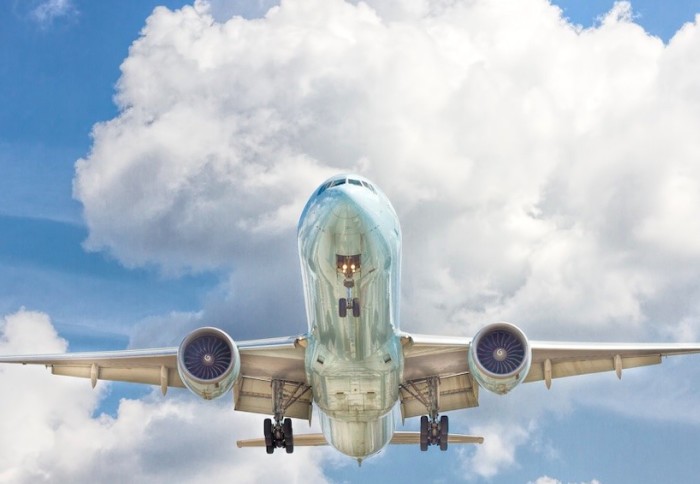Clouds created by aircraft have a bigger impact than the emissions they emit

Understanding how aircraft contrails effect climate change, could offer a route to reduce global warming fast, says Dr Edward Gryspeerdt.
Greenhouse gases (GHGs) aren’t the only contributors to global warming created by flying – the clouds formed high up in the atmosphere by planes have a significant impact too.
Understanding them better could offer valuable ways to change aviation and reduce its impact on the climate.
Dr Edward Gryspeerdt, Research Fellow and lecturer, in the Grantham Institute, explains more about his work studying the impact of human activity on cloud formation.
What do clouds have to do with climate change?
Essentially, all clouds are reflective and create a cooling effect on the climate, but some are also very good at trapping heat, acting as a blanket across the planet and helping to warm it further. So some clouds decrease global warming, while others increase it.
Clouds are made from lots of droplets of water and maybe a few crystals of ice – each of these forms around an aerosol particle, such as sea salt, desert dust, soot from burning fossil fuels, and sulfuric acid.
If you increase particles, you get more droplets or ice crystals in that cloud, and that changes its properties.

How are aviation and shipping linked to clouds?
We know that human activity, such as shipping and aviation, is changing clouds. Ships produce a lot of particulates and so do planes.
Aircraft contrails – that plume you see forming behind a plane as it flies along – have a significant impact on the climate. When jet fuel burns, it creates water and little particles of soot – as this leaves the engine the water droplets quickly freeze to ice.
If the conditions are right, these ice crystals grow and spread across the sky as a cloud. This happens when a plane travels through an area where a cloud was waiting to form, with the ice crystals forming behind the plane, triggering the formation of a larger cloud.

How do these clouds impact the climate?
In a nutshell, ships change existing clouds, making them cool the Earth further, while clouds created by planes warm the Earth.
"The warming effect of the contrails in the atmosphere today, is more than all the CO2 that has been emitted by aircraft since the dawn of flight." Dr Gryspeerdt
Ships produce a lot of aerosols but typically emit them low in the atmosphere – this changes clouds near to the Earth’s surface, making them brighter and creating a cooling effect.
Clouds formed from aviation are high up (10km up in the troposphere), and are very cold, making them good at stopping heat leaving the Earth and keeping it warm.
So by producing more of these high-level clouds, aircraft are warming the climate through more than just their greenhouse gas emissions.
How significant is the warming effect of clouds from aviation?
It’s significant. The warming effect of contrails is more than half the total climate impact of aircraft.
If you take the contrails that are in the atmosphere today, the warming effect of them is more than all the CO2 that has been emitted by aircraft since the dawn of flight.

This doesn’t sound good – what can we do?
"By understanding contrails, we can find ways to reduce their impact. For example, redirecting planes away from where a cloud is about to form..." Dr Gryspeerdt
Ideally, we’d reduce flying and all its associated emissions. However, there are benefits to society from flying and such drastic changes are possibly unrealistic right now.
But by understanding contrails, we can find ways to reduce their impact. For example, redirecting planes away from where a cloud is about to form, using different types of aircraft or fuel, and flying at different heights, may all help reduce contrails and their warming effect.
So are the contrails or GHGs emitted by aircraft worse for the climate?
There’s a trade-off – GHGs emitted by aircraft stay in the atmosphere for hundreds of years. So if you reroute a flight to avoid a warming contrail, you still have the CO2 and warming from the extra fuel burnt, so you have to be sure about the benefit of what you’re going to do.
Watch more timelapse videos of clouds, on Dr Gryspeerdt's blog.
Are you optimistic we will solve climate change?
In some ways I am optimistic because we actually know what the solution is, but it’s the doing bit that is difficult – we just need to get on and do it.
We have to work out how to do it in a way that is effective and quick. This is challenging, but there are still pathways that will see us avoid dangerous climate change.
Article text (excluding photos or graphics) © Imperial College London.
Photos and graphics subject to third party copyright used with permission or © Imperial College London.
Reporter
Jez Fredenburgh
The Grantham Institute for Climate Change
